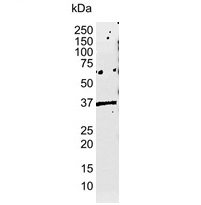HLA E antibody | MEM-E/02

Mouse anti Human HLA E
- Product Type
- Monoclonal Antibody
- Clone
- MEM-E/02
- Isotype
- IgG1
- Specificity
- HLA E
| Mouse anti Human HLA-E antibody, clone MEM-E/02 reacts with the denatured heavy chain of the non-classical MHC class I HLA-E molecule. HLA-E exists as a heterodimer consisting of a heavy chain and a light chain, beta-2-microglobulin. Mouse anti Human HLA-E antibody, clone MEM-E/02 does not recognize native HLA-E by flow cytometry and does not cross react with HLA-A, -B, -C or G. |
- Target Species
- Human
- Product Form
- Purified IgG - liquid
- Preparation
- Purified IgG prepared by affinity chromatography on Protein A from ascites
- Buffer Solution
- Phosphate buffered saline
- Preservative Stabilisers
- <0.1% sodium azide (NaN3)
- Immunogen
- Recombinant HLA-E.
- Approx. Protein Concentrations
- IgG concentration 1.0 mg/ml
- Regulatory
- For research purposes only
- Guarantee
- 12 months from date of despatch
Avoid repeated freezing and thawing as this may denature the antibody. Storage in frost-free freezers is not recommended.
| Application Name | Verified | Min Dilution | Max Dilution |
|---|---|---|---|
| Flow Cytometry | |||
| Western Blotting |
- Western Blotting
- Mouse anti Human HLA E antibody, clone MEM-E/02 detects a band of approximately 43 kDa.
References for HLA E antibody
-
Menier; C. et al. (2003) Characterization of monoclonal antibodies recognizing HLA-G or HLA-E: new tools to analyze the expression of nonclassical HLA class I molecules.
Hum Immunol. 64: 315-26. -
Ashrafi, G.H. et al. (2005) E5 protein of human papillomavirus type 16 selectively downregulates surface HLA class I.
Int J Cancer. 113: 276-83. -
Griffin, C. et al. (2005) Characterization of a highly glycosylated form of the human cytomegalovirus HLA class I homologue gpUL18.
J Gen Virol. 86: 2999-3008. -
Derré, L. et al. (2006) Expression and release of HLA-E by melanoma cells and melanocytes: potential impact on the response of cytotoxic effector cells.
J Immunol. 177: 3100-7. -
Trichet, V. et al. (2006) Complex interplay of activating and inhibitory signals received by Vgamma9Vdelta2 T cells revealed by target cell beta2-microglobulin knockdown.
J Immunol. 177: 6129-36. -
Coupel, S. et al. (2007) Expression and release of soluble HLA-E is an immunoregulatory feature of endothelial cell activation.
Blood. 109: 2806-14. -
Cui, C.H. et al. (2011) Dystrophin conferral using human endothelium expressing HLA-E in the non-immunosuppressive murine model of Duchenne muscular dystrophy.
Hum Mol Genet. 20 (2): 235-44. -
Djajadiningrat, R.S. et al. (2015) Classic and nonclassic HLA class I expression in penile cancer and relation to HPV status and clinical outcome.
J Urol. 193 (4): 1245-51.
View The Latest Product References
-
Eugène, J. et al. (2020) The inhibitory receptor CD94/NKG2A on CD8(+) tumor-infiltrating lymphocytes in colorectal cancer: a promising new druggable immune checkpoint in the context of HLAE/β2m overexpression.
Mod Pathol. 33 (3): 468-482.
- RRID
- AB_324025
- UniProt
- P13747
- Entrez Gene
- HLA-E
- GO Terms
- GO:0002474 antigen processing and presentation of peptide antigen via MHC class I
- GO:0042612 MHC class I protein complex
- GO:0016021 integral to membrane
- GO:0006955 immune response
- GO:0032393 MHC class I receptor activity
- GO:0050776 regulation of immune response
- GO:0060333 interferon-gamma-mediated signaling pathway
- GO:0060337 type I interferon-mediated signaling pathway
MCA2193
If you cannot find the batch/lot you are looking for please contact our technical support team for assistance.
Please Note: All Products are "FOR RESEARCH PURPOSES ONLY"
View all Anti-Human ProductsAlways be the first to know.
When we launch new products and resources to help you achieve more in the lab.
Yes, sign me up